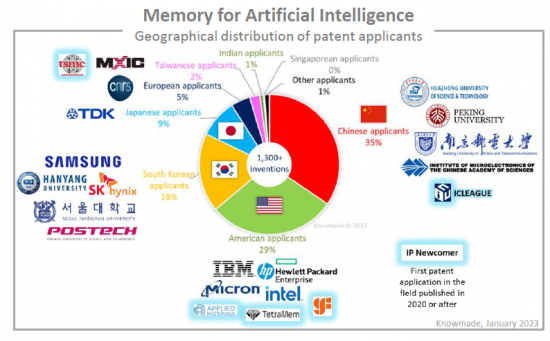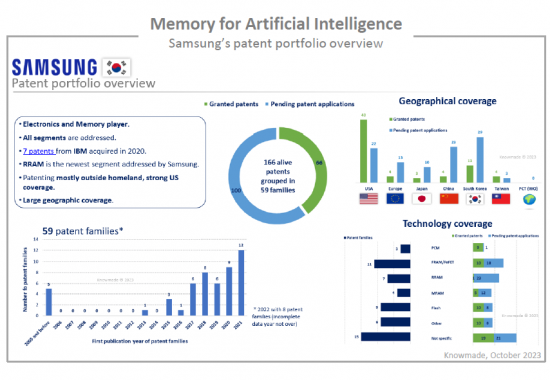 |
市场调查报告书
商品编码
1192495
面向人工智能 (AI) 的存储器专利态势分析 (2023)Memory for Artificial Intelligence Patent Landscape Analysis 2023 |
||||||
本报告分析了与人工智能 (AI) 存储器相关的最新专利情况,概述了适用于人工智能/机器学习 (AI/ML) 应用的存储器技术,并提供了近期专利申请和批准的概述. 我们将彙编和发布主要知识产权公司(专利所有者/申请人)的趋势、细分趋势、概况和专利组合等信息。
关键分析特征
- 包含 100 多张幻灯片的 PDF
- 包含本报告中分析的所有专利(超过 1,300 个专利家族)的 Excel 数据库,包括专利分类和更新在线数据库的超链接
- 世界专利趋势:专利公开时间、专利申请国家等方面的变化。
- 确定每个细分市场中的主要专利受让人和新进入者
- 了解专利活动的状态(活跃/不活跃)和知识产权趋势(活跃、减速、稳定)
- 确定知识产权联盟(联合专利申请)和知识产权转让(专利所有权的变更)
- 根据为神经形态计算开发的技术对专利进行分类(共 9 个领域):ReRAM、PCM、MRAM、FRAM/FeFET、闪存、DRAM、SRAM 等。
- 8 家主要知识产权公司的知识产权概况:专利组合概览(知识产权趋势、分类、法律地位、地理范围等)、知识产权合作、主要专利、近期专利申请活动
分析背景
近年来,神经拟态计算作为后摩尔定律时代的一项很有前途的技术出现了。 神经形态计算系统的特点是高连接性和并行性,以及相对较低的功耗和内存处理。 为了在硬件中实现这样的系统,我们需要模拟生物有机体的人工神经元和突触。 两者都应该是节能的、可扩展的,并且能够实施相关的学习规则以促进大规模的神经形态功能。 为此,近年来人们进行了□□许多尝试,使用 MRAM、PCM、ReRAM(存储器)、CB-RAM、FeRAM、FeFET 和突触晶体管等新型存储器来创建人工神经元和突触。
因此,Knowmade 探索了与人工智能/机器学习 (AI/ML) 应用的存储器技术相关的专利格局,从材料和设备到使用它们的系统和方法,再到存储器技术(ReRAM、PCM、MRAM、FRAM/FeFET、闪存、DRAM、SRAM 等),我们正在推出一份新报告,目的是获得全面的了解。
本报告旨在回答以下问题:
- 是否有某些记忆技术比其他技术更适合人工智能/机器学习 (AI/ML)?
- 该领域的主要专利持有人和专利申请人有哪些?
- 专利涵盖的技术问题是什么? 还有,保护的对像是什么? (装置、系统、方法等)
- 专门为人工智能/机器学习 (AI/ML) 开发的内存有哪些特点?

专利分类
该专利涵盖新兴的基于电阻的内存技术(ReRAM、PCM、MRAM)、基于极化的新兴内存技术(FRAM/FeFET),以及为神经形态计算开发的内存技术的传统内存技术。(闪存、DRAM、SRAM) ),其他存储技术(突触离子晶体管,基于二维或一维材料的设备,混合材料,钙钛矿,纳米粒子,量子物理学,有机材料,斯格明子等),未指定(未指定存储技术类型)。
所有新兴存储器目前都在调查中,FRAM 保护近年来呈上升趋势。 RRAM是世界上拥有最多发明和可执行专利的技术。

IP概况:关注主要IP公司的专利组合
知识产权报告包含八家主要知识产权公司的知识产权概况:IBM、三星、应用材料、TDK、SK 海力士、旺宏、惠普和 TetraMem。
我们分析了每家公司与 AI 存储器技术相关的专利组合,并提供了诸如其优势、增强潜力、知识产权活动水平、主要知识产权合作、近期专利活动和主要发明增加等信息。

Excel专利数据库
该报告包括一个广泛的 Excel 数据库,其中包含已分析的 1,300 多个专利家族(发明)。 这个有用的专利数据库是多标准可搜索的,包括专利公开号、最新在线数据库的超链接(文本、法律状态等)、优先权日期、标题、摘要、专利受让人和专利当前状态。包括合法状态,9 段(RRAM、PCM、MRAM、FeRAM/FeFET、闪存、DRAM、SRAM、其他、未指定)。
本报告提及的公司(部分)
- 行业:IBM、三星、惠普、TDK、美光、SK 海力士、Macronix、英特尔、TetraMem、GlobalFoundries、富士通、泰雷兹、松下、索尼、东芝/铠侠、应用材料、华邦电子, Honeywell, Monolithic 3D, Qualcomm, TSMC, Gyrfalcon, I&F, ICLeague, Merck, NTT, Olympus, Rohm, HRL Labs, Semron, Synopsys, Texas Instruments, Western Digital, Crossbar, Weeebit, Nantero等。
- 研究机构:研究机构:华中科技大学、北京大学、南京邮电大学 (NJUPT)、汉阳大学、首尔国立大学 (SNU)、浦项科技大学与技术(POSTECH),中国科学院微电子研究所(IMECAS),韩国先进科学技术研究所,宁波材料技术与工程研究所(NIMTE),清华大学,CNRS - 法国国家研究中心,復旦大学,南京大学、电子科技大学(UESTC)、河北大学、北京航空航天大学、福州大学、南开大学(NKU)、山东科技大学、成均馆大学、国民大学、加州理工学院(Caltech) ) )、哈佛大学、CEA - 法国替代能源和原子能委员会等。
内容
介绍
执行摘要
专利概况
- 专利公布时间表
- 知识产权公司所在地
- 工业知识产权公司所在地
- 主要专利申请人排名
- 专利的当前法律状态
- 专注于工业
- 工业专利权人的类型
- 公司持有的专利:当前的法律地位
- 工业知识产权公司的时间表
- 各行业持有的有效专利的地理覆盖范围
- 工业专利受让人的知识产权领导
- 工业专利受让人的主要知识产权合作
- 三星/IBM 知识产权合作
- SK 海力士 IP 合作
- 运营公司:概览
- 关注研究机构
- 研究机构所在地
- 研究机构专利权人的知识产权领导
- 学术 IP 播放器时间表
- 研究机构的主要知识产权合作
- 研究机构持有的有效专利的地理分布
- 研究机构:概述
专利分类
- AI/ML 的内存技术
- 专利分类
- 每种内存技术的专利出版物的时间变化
- AI/ML 存储技术的主要专利申请人
- 其他内存技术
- 新 NVM(非易失性存储器)专利权人的 IP 领导地位
- 主要专利家族
- 分析方法
- 选择关键专利
- 其他着名的专利家族
主要公司知识产权概况
- IBM
- Samsung
- Applied Materials
- TDK
- SK Hynix
- Macronix International
- Hewlett Packard
- TetraMem
- 拥有 RRAM 核心业务的公司:由于内存相关专利未明确提及 AI/ML 应用,因此在本报告中省略
结论
附录
知名演讲
Are there specific memory technologies claimed in patents that are more suitable than others for artificial intelligence/machine learning (AI/ML) applications? Who are the key patent owners and the most active patent applicants in the field?
Report's Key Features:
- PDF>100 slides
- Excel database containing all patents analyzed in the report (>1,300 patent families), including patent segmentations and hyperlinks to an updated online database.
- Describing the global patenting trends, including time evolution of patent publications, countries of patent filings, etc.
- Identifying the main patent assignees and the IP newcomers in the different segments.
- Determining the status of their patenting activity (active / inactive) and their IP dynamics (ramping up, slowing down, steady).
- Identifying the IP collaborations (patent co-filings) and IP transfers (changes of patent ownership).
- Patents categorized into 9 segments according to technologies developed for neuromorphic computation: ReRAM, PCM, MRAM, FRAM/FeFET, Flash, DRAM, SRAM, etc.
- IP profile of 8 key IP players: patent portfolio overview (IP dynamics, segmentation, legal status, geographic coverage, etc.), IP collaborations, key patents, and recent patenting activity.
Report context:
In recent years, neuromorphic computing has emerged as a promising technology in the post-Moore's law era. Neuromorphic computing systems are highly connected and parallel and consume relatively low power and processes in memory. Artificial neurons and synapses that mimic biological ones are needed to implement such a system on hardware. Both must be power-efficient, scalable, and capable of implementing relevant learning rules to facilitate large-scale neuromorphic functions. To this end, numerous efforts have been made over the last few years to create artificial neurons and synapses using emerging memories, including magnetoresistive random-access memory (MRAM), phase-change memory (PCM), resistive random-access memory (ReRAM or memristors), conductive bridging random-access memory (CB-RAM), ferroelectric random-access memory (FeRAM), ferroelectric field-effect transistor (FeFET), synaptic transistors, and others.
In this context, Knowmade is releasing a new report that aims to provide a comprehensive view of the patent landscape related to memory technologies for artificial intelligence/machine learning (AI/ML) applications, from materials and devices to the systems and methods that use them, categorized into memory technologies (ReRAM, PCM, MRAM, FRAM/FeFET, Flash, DRAM, SRAM, etc.).
In this report, we aim to answer the following questions:
- Is there a specific memory technology more suitable than others for artificial intelligence/machine learning (AI/ML)?
- Who are the main patent owners and patent applicants in the field?
- What are the technical challenges targeted in patents, and what is protected (device, system, method, etc.)?
- Are there memory properties developed more specifically for intelligence/machine learning (AI/ML)?

Patent landscape analysis is a powerful tool for understanding the competitive and technological environment. It makes it possible to identify new players in emerging industries long before they enter the market while providing a better understanding of their expertise and know-how of a specific technology. Overall, patenting activity (patent filings) reflects the level of R&D investment made by a country or player in a specific technology while providing clues as to the technology readiness level reached by the main IP players. What's more, the technology coverage and the geographical coverage of the patent portfolios are closely related to the business strategy of IP players.
A diversified ecosystem of semiconductor companies
A mix of IC and memory players, universities, and R&D centers are competing for innovation at all stages of the R&D ladder. Industrial companies' patenting activity took off in 2015 after R&D efforts were focused on research and fundamental physics knowledge. American and Korean industrials and Chinese and Korean universities mainly hold patents. Top patent assignees are well-established semiconductor companies, and IBM and Samsung have a leading IP position. New players such as Applied Materials, TSMC, GlobalFoundries, TetraMem, and ICLeague are entering the game, and their intellectual property (IP) may become important in the coming years.
Patent segmentation
The patents have been categorized according to the memory technologies developed for neuromorphic computation: resistance-based emerging memory technology (ReRAM, PCM, MRAM), polarization-based emerging memory technology (FRAM/FeFET), traditional memory technologies (Flash, DRAM, SRAM), other memory technologies (synaptic ionic transistor, devices based on 2D or 1D materials, hybrid materials, perovskites, nanoparticles, quantum physics, organic materials, skyrmions, etc.), and not specific (type of memory technology not specified).
All emerging memories are currently under investigation, with an upward trend for protecting FRAM in recent years. RRAM is the technology with the most inventions and the most significant number of enforceable patents worldwide.

IP profiles: focus on the top IP players' patent portfolios
The IP report includes the IP profile of eight key IP players: IBM, Samsung, Applied Materials, TDK, SK hynix, Macronix, HP, and TetraMem.
Each player's patent portfolio related to memory technologies for AI applications is analyzed to provide an overview of its strengths, potential for reinforcement, level of IP activity, main IP collaborations, recent patenting activity, and inventions that stand out.

Useful Excel patent database
This report includes an extensive Excel database with the 1,300+ patent families (inventions) analyzed in this study. This useful patent database allows for multicriteria searches and includes patent publication numbers, hyperlinks to an updated online database (original documents, legal status, etc.), priority date, title, abstract, patent assignees, patent's current legal status, and nine segments (RRAM, PCM, MRAM, FeRAM/FeFET, Flash, DRAM, SRAM, other, not specific).
Companies mentioned in the report (non-exhaustive)
- Industrials: IBM, Samsung, HP, TDK, Micron, SK Hynix, Macronix, Intel, TetraMem, GlobalFoundries, Fujitsu, Thales, Panasonic, Sony, Toshiba/Kioxia, Applied Materials, Winbond Electronics, Honeywell, Monolithic 3D, Qualcomm, TSMC, Gyrfalcon, I & F, ICLeague, Merck, NTT, Olympus, Rohm, HRL Labs, Semron, Synopsys, Texas Instruments, Western Digital, Crossbar, Weeebit, Nantero, etc.
- Research organizations: Huazhong University of Science and Technology, Peking University, Nanjing University of Posts & Telecommunications (NJUPT), Hanyang University, Seoul National University (SNU), Pohang University of Science and Technology (POSTECH), Institute of Microelectronics, Chinese Academy of Sciences (IMECAS), Korea Advanced Institute of Science and Technology, Ningbo Institute of Materials Technology & Engineering (NIMTE), Tsinghua University, CNRS - French National Research Center, Fudan University, Nanjing University, University of Electronic Science and Technology of China (UESTC), Hebei University, Beihang University, Fuzhou University, University of Nankai (NKU), Shandong University of Science and Technology, Sungkyunkwan University, Kookmin University, California Institute of Technology (Caltech), Harvard University, CEA - French Alternative Energies and Atomic Energy Commission, etc.
TABLE OF CONTENTS
INTRODUCTION
- Questions answered by the patent and scape
- Scope of the report
- Reading guide
- Main patent assignees mentioned in this report
EXECUTIVE SUMMARY
PATENT LANDSCAPE OVERVIEW
- Time evolution of patent publications
- IP players location
- Industrial IP players location
- Ranking of main patent assignees
- Current legal status of the patents
- Focus on industrials
- Typology of industrials patent assignees
- Current legal status of patents held by industrials
- Timeline of industrial IP players
- Geographical coverage of alive patents held by industrial players
- IP leadership of industrial patent assignees
- Main IP collaborations of industrial patent assignees
- Samsung / IBM IP collaboration
- SK Hynix IP collaborations
- Industrial companies: summary
- Focus on research organizations
- Research organization location
- IP leadership of research organization patent assignees
- Timeline of academic IP players
- Main IP collaborations of research organizations
- Geographical distribution of alive patents held by research organizations
- Research organizations: summary
PATENT SEGMENTATION
- Memory technologies for AI/ML
- Patent segmentation
- Time evolution of patent publications for each memory technology
- Main patent assignees by memory technologies for AI/ML
- Other memory technologies
- IP leadership of patent assignees for emerging NVM
- Key patent families
- Methodology
- Selection of key patents
- Other notable patent families
IP PROFILES OF KEY PLAYERS
- IBM
- Samsung
- Applied Materials
- TDK
- SK Hynix
- Macronix International
- Hewlett Packard
- TetraMem
- Companies with RRAM core business, but being absent of this report since none of their memory-related patents explicitly mention AI/ML application
CONCLUSION
ANNEX
- Methodology for patent search, selection and analysis
- Methodology to identify key patents and key IP players
- Terminology








